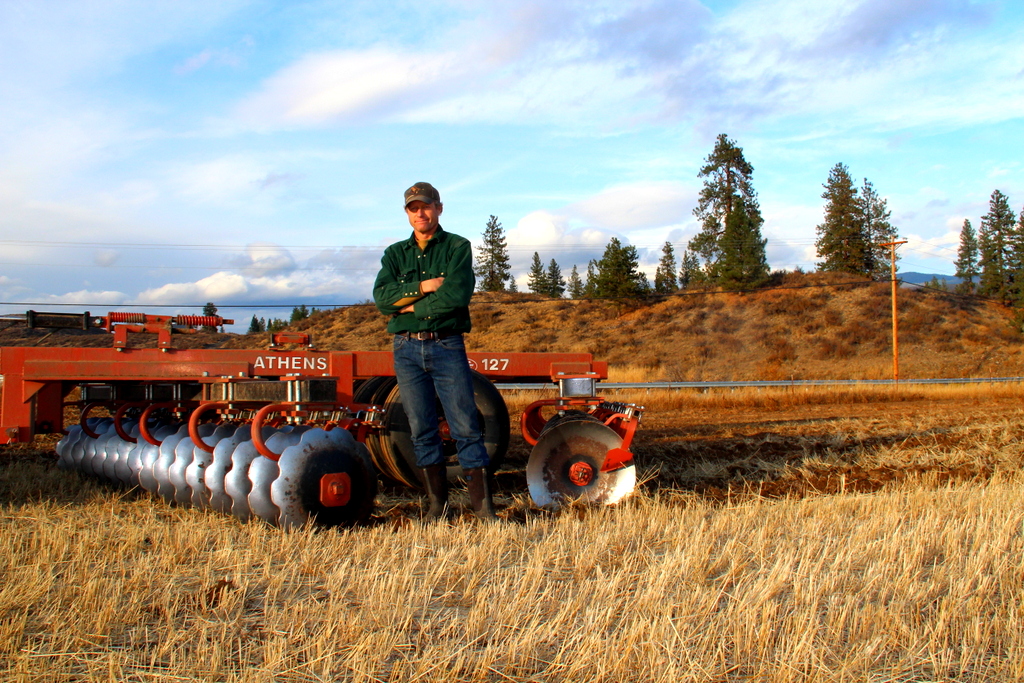
This autumn has been lullaby- mellow with endless mild days, coolish nights, even a little bit of rain. Not the full days of rain we might hope for, but enough to freshen the air and soil. One could easily forget that we are entering the 4th week of October as I write this and still, we’ve not had a hard frost up here in the Rendezvous. Truth to tell, we continue to pluck tomatoes from our garden! Very soon, however, we’ll know if my prediction for an early winter is correct or not?
Southbound geese earlier in the month, as well as sandhill cranes and deer moving out of the snowless mountains could be signs justifying my prediction. The summer song-birds are gone and now we only hear robins in the morning and a few chickadees. Many a year we’ve had snow on Halloween. So…
It has been fine enough weather for our field work and I keep in mind how late it is getting. We’ve treated our grain stubble with digester and have been following with the heavy field disks to incorporate straw and soil. Every few years, we actually turn some fields completely over with our moldboard plows and this year we’ll be doing so beginning soon.
We plow for a variety of reasons and I’ve grown to favor fall plowing to spring plowing in most cases. We plow to kill out certain grasses, alfalafa, or deep rooted weeds. Some of our leased ground had been fallow for many years and had nice stands of “old growth” quack grass and other weeds. By first dicing up the ground with a disk, then turning the soil completely over (or under) a foot or more deep in the fall, these plants will die over the winter. Because we do not use herbicides, plowing is about the only way to “kill” things organically. I prefer to call this process “complete over haul.”
To be sure, we use our plows sparingly. Although we pride ourselves here at Bluebird for having fairly “clean fields” let’s talk weeds for a bit.
This past summer, we had our first bad outbreak of lambsquarter in one of our fields. Lambsquarter is an annual that likes fertility, is fast growing and has zillions of little seeds that generally remain green and hold lots of moisture at harvest. When the grain itself is cured and ready for combining, the lambsquarter can be a month from drying down. The problem here can be two-fold. First, the lambsquarter can slow down the combining and makes the grain harder to thresh. Secondly, because the seed is so moist it can ruin the grain in storage.
There are a couple ways to deal with weedy fields. Wind rowing grain was common place all over the northern prairie on up into Canada before herbicides came onto the market. Wind-rowing means the grain plants were cut with a sickle and pulled into a windrow where they were left to dry out. Wind-rowing was practiced to deal with weeds – in a windrow the weeds dry down and the grain then thresehes much easier. Also, it was used to expedite harvest. In northern climates grain can take a long time to cure with autumn coming on and heating units drop. Grain was thus cut in its hard dough stage to help the curing process or hardening/finishing of the actual kernels. Grain would lie in-row for maybe a week, then was ready to thresh. These days in “conventional” farming, a very high percentage of grain is sprayed with a light dose of Roundup at it’s hard dough stage. This kills the grain plant and, of course, any weeds that might be present plus it eliminates the two-step procedure of swathing, then combining with a pick-up header on a combine. Nifty…
We don’t believe in chemicals and so I guess you could call us “old school.” Bringing this back around to plowing, we swathed then combined the grain in this one field. There was some grain loss in the process but it worked fine other wise. However, but all the weedseed of course went back onto the field. We will fall plow this field to bury that seed bank. In the spring, we’ll only cultivate deep enough to make a seed bed to sow our “good” seed, and not so deep as to bring up the “bad” seed. This whole outbreak I now believe was caused by us disking too deep this spring when we turned under our winter peas. In so doing, I think we brought to light weed seed that had been dormant for dozens of years.
Phew… perhaps we should continue these cultivation methods, weed-talk next letter. For now, I want you to all know that we’ve begun running this years crop and indeed, the quality looks swell. No, you should not be finding any weeds! Our cleaning line takes out any remaining weeds before we mill and/or package the grains.
And so please let us know what you think of this years crop? Please get out and enjoy this bittersweet time of year. Be careful on Halloween of all the tricksters racing about and next time we’ll revisit my weather predictions. Also, we’ll know who wins the World Series!
Until then, Yours Farmer Sam


